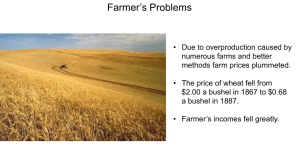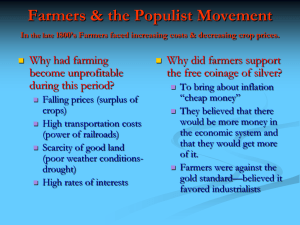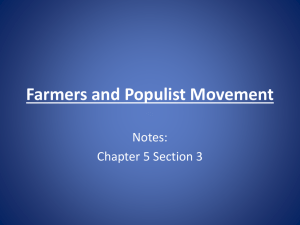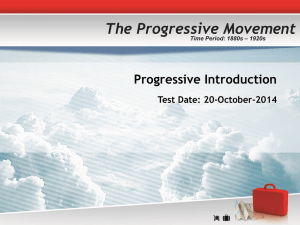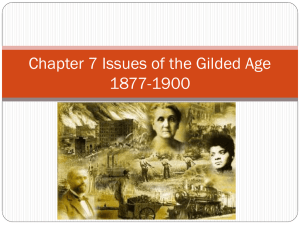Populism PowerPoint
advertisement
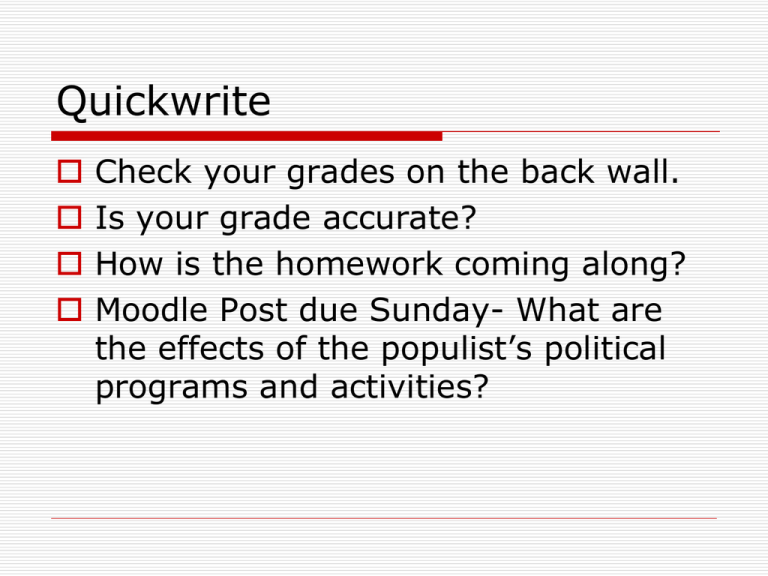
Quickwrite Check your grades on the back wall. Is your grade accurate? How is the homework coming along? Moodle Post due Sunday- What are the effects of the populist’s political programs and activities? Populism How Ya' Gonna' Keep 'Em Down on the Farm?: The Rise of Populism Beginning in the 1870s, worsening conditions in rural America caused many people to abandon their farms. At the same time, changes in farming practices and the agricultural marketplace made farmers more dependent on commercial decisions made by big-city businessmen. In reaction to these trends, farmers began to take political action that led to the emergence of the national Populist movement in the 1890s. This lecture investigates changing agricultural conditions in the United States during the nineteenth century and explores how many rural Americans mobilized to deal with their crushing economic and political problems. Things to keep in mind: How did agriculture change in the United States between 1870 and 1900? How did farmers try and protect their economic interests and way of life during this period? Were they successful? Why or why not? Who were the Populists? Why were they so appealing to farmers? Did they change American politics? If so, how? Changes in Agriculture 1. Mechanization of agriculture New machines benefitted many, but they also has disadvantages. Cost a lot Need upkeep and repair Financial Risk Changes in Agriculture Opening of new lands Farmers began mortgaging their property in order to farm more land. Theoretically, more land meant more crops and more money. Bankers charged high interest rates to farmers. By the mid-1880s, Midwestern farmers had the highest per capita debt in the United States. Changes in Agriculture Specialization in farm products Farmers prefered to stick to known crops. Lack of diversification made them vulnerable to parasites (on the land and in the banks). Changes in Agriculture Changing character of markets for agricultural goods From 1860 to 1900, agricultural products comprised 75% of the United States' total export trade. Farmers, however, did not understand this trade or markets well. Middlemen, especially railroad agents and owners, profited from the ignorance of the farmers while farmers struggled. Factors farmers could NOT control Business Cycles- ups and downs Credit- rates and terms Transportation- Railroad Labor Supply Price Structure Government policies What should the farmers do about these problems??? Turn to a classmate and explain. They get political!!! The Grange The Grange worked to pass pro-farmer legislation. Farmers could pool resources- machinery, supplies, and insurance. By 1875, the membership had passed 850,000. Cooperatives- founded banks, pushed through legislation regulating railroads and grain elevators, and campaigned for political candidates Populist Platform Unlimited Minting of Silver Workers wages and 8 hr. workday Government ownership of railroads Gov. Ownership of Communications Progressive Income Tax Increase the circulation of $- Inflation Quickwrite- How would each of these items help farmers? 1896- William Jennings Bryan Populist Candidate Cross of Gold Speech (Coin silver and increase Inflation) He lost, but issues were important. Contributions from: Stanley K. Schultz, Professor of History William P. Tishler, Producer Populism Simulation Homestead Act- 1862 Congratulations!!!! The first 24 students who get to the other side of the room and claim a piece of “land” will become owners of 160 acre farms. Fold your paper into ¼ sections and draw a farmhouse, garden and corral on ¼. Farm Life in America 1860 to 1900 As a farmer, you will now experience farm life in the 1870’s. As you face challenges you will tear pieces of your farm off to represent the farmers losing their land to the different challenges of the period. Lack of Diversification Farmland Now choose whether you are going to be a wheat, corn or hay farmer and draw fields in the rest of your land. -All fields must be the same kind of crop to represent the lack of diversification. Good News!!! Bumper Crop Your first crop is a bumper crop and you decide to use your profit as a down payment on another ¼ section of land. You use your title to the other land as collateral for the loan. New Technology Bank Loans Wheat farmer buys thresher. Corn farmer buys cornhusker. Hay farmer buys hay binder. You use your new land as collateral for the purchase. Problems Drought In 1870 a severe drought swept the plains. The inability to meet debt obligations meant many farmers had to sell part of their land in order to survive. Tear off ¼ of your land to represent this sale. Problems Locusts The drought led to locust swarms that consumed huge quantities of your crops. The inability to get your product to market means you fail to make payments and must sell more land- tear away another ¼. Good News/Bad News Another Bumper Crop This year you receive perhaps your best crop ever. . . . But you harvested late to allow it to grow to full size and now the market is flooded. No one will buy your crop. You eat a lot of corn (or wheat, or hay) but you end up losing another ¼! More Good News (Really???) Another Bumper For the second year in a row you have great success (you are really getting this farming thing down). You harvest and prepare to ship your product to market in the east. . . but the railroad company has doubled the cost to transport your goods to market. ¼ more is repossessed. Farm Simulation Debrief Simulation Obtain land Lack of Diversification Good Crops New Equipment (loans) More land (debt) Drought Locusts Flooded Markets Railroad Companies Debrief 1. Write down three ways the simulation was similar to life for an actual farmer in the 19th century. 2. Write down one way the simulation was different. Beginning in the 1870s, worsening conditions in rural America caused many people to abandon their farms. At the same time, changes in farming practices and the agricultural marketplace made farmers more dependent on commercial decisions made by big-city businessmen. In reaction to these trends, farmers began to take political action that led to the emergence of the national Populist movement in the 1890s. This lecture investigates changing agricultural conditions in the United States during the nineteenth century and explores how many rural Americans mobilized to deal with their crushing economic and political problems. Things to keep in mind: How did agriculture change in the United States between 1870 and 1900? How did farmers try and protect their economic interests and way of life during this period? Were they successful? Why or why not? Who were the Populists? Why were they so appealing to farmers? Did they change American politics? If so, how? Negotiations Simulation Negotiation is a dialogue between two or more people or parties, intended to reach an understanding, resolve point of difference, or gain advantage in outcome ... Today, you will assume the role of a negotiator for either the Populists (supporting farmers and workers) or for a private company (railroad, communications, etc.). Issues for Negotiation 1. 2. 3. Workers wages- populists want to see the wages for the average worker increase. Progressive Income TaxPopulists want the wealthy to pay a larger amount of the tax burden. Government Control of railroads. Railroads have a monopoly on shipping and farmers are in a bad position. 1. Employers want to keep wages low. 2. Wealthy want to keep money. 3. Railroads want to keep control of the railroads. Negotiation Process 1. 2. 3. 4. 5. 6. 7. Get together with your group and decide what it is you want to achieve (see above and brainstorm). Appoint a lead negotiator. Come to the negotiating table and greet the other side. Populist lead negotiator presents their ideas. Both sides should clarify if there is any misunderstanding. Caucus- teams leave the negotiating table and go to a private area. The (employer, wealthy, railroad owners) discuss whether to accept the offer. Both sides return to the table. The (employer, wealthy, railroad owners) informs the other lead negotiator whether the offer has been accepted. They may propose a counter-offer. If there is a counter offer, then the populists leave and caucus to discuss. If and when an agreement is made, then it is written in specific language for all to see. Everyone must agree that it is what he or she understands. Everyone shakes hands and goes home for the evening. Negotiation Process Continued 1. 2. 3. Both sides return to the table. The (employer, wealthy, railroad owners) informs the other lead negotiator whether the offer has been accepted. They may propose a counteroffer. If there is a counter offer, then the populists leave and caucus to discuss. If and when an agreement is made, then it is written in specific language for all to see. Everyone must agree that it is what he or she understands. Everyone shakes hands and goes home for the evening. Negotiation Debrief Did you get
